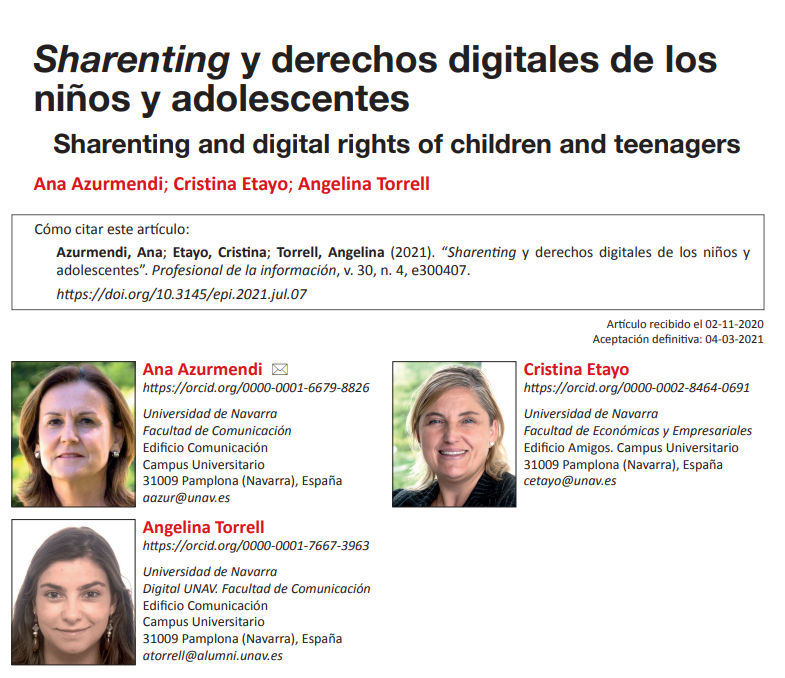
Sharenting y derechos digitales de los niños y adolescentes
On Sale
€15.00
€15.00
Resumen: El sharenting –difusión en redes sociales de imágenes y comentarios sobre los hijos, menores de edad, por sus padres o madres o por ambos simultáneamente–, es un fenómeno creciente (Kopecky et al., 2020; Bessant, 2018). La pandemia del Covid-19 ha incrementado el uso de las redes sociales, sobre todo durante los meses de confinamiento. Las redes sociales han ayudado a paliar la separación, y en la medida en que la comunicación con familiares y amigos ha sido frecuente, también han contribuido a un aumento del sharenting (Saud; Mashud; Ida, 2020). Aún se desconoce si este fenómeno es puntual o si, por el contrario, el confinamiento ha contribuido a cambiar las actitudes sociales hacia esta actividad parental (Bessant; Nottingham; Oswald, 2020). En cualquier caso, se ha puesto de manifiesto la necesidad de reflexionar sobre el alcance de los derechos que entran en juego en el sharenting. La investigación que se presenta lo estudia desde los derechos a la libertad de expresión de los padres y los derechos a la vida privada de los niños bajo su tutela y a su identidad digital; también desde la perspectiva de la visión del menor hacia esta actividad parental. Una revisión de la bibliografía muestra la variedad de argumentos que han expresado las modalidades de equilibrio entre esos derechos presentes en el sharenting. La investigación se completa con una encuesta a niños y adolescentes entre 13 y 18 años, realizada en marzo de 2020. Se responde así a la crítica sobre los estudios de derechos de los menores de no incluir su propia visión (Cowden, 2016).
Abstract: Sharenting –dissemination on social networks of images and comments about children, minors, by their parents–, is a growing phenomenon (Kopecky et al., 2020; Bessant, 2018). The Covid-19 pandemic has increased the use of social networks, especially during the months of confinement. Social networks have helped to alleviate the separation, and to the extent that communication with family and friends has been frequent, they have also contributed to an increase in sharenting (Saud; Mashud; Ida, 2020). It is still unknown if this phenomenon is specific or if, on the contrary, confinement has contributed to changing social attitudes towards this parental activity (Bessant; Nottingham; Oswald, 2020). In any case, the need to reflect on the consequences and on the rights that come into play in sharenting has become evident. The research presented studies sharenting from the right to freedom of expression of parents, and the rights to private life of children under their guardianship and their digital identity; also from the perspective of the minor’s vision of this parental activity. A review of the bibliography shows the variety of arguments that have expressed the modalities of balance between these rights present in sharenting. The research is completed with a survey of children and adolescents between 13 and 18 years old, carried out in March 2020. This is how we respond to the criticism of the studies on the rights of minors for not including their own vision (Cowden, 2016).
Abstract: Sharenting –dissemination on social networks of images and comments about children, minors, by their parents–, is a growing phenomenon (Kopecky et al., 2020; Bessant, 2018). The Covid-19 pandemic has increased the use of social networks, especially during the months of confinement. Social networks have helped to alleviate the separation, and to the extent that communication with family and friends has been frequent, they have also contributed to an increase in sharenting (Saud; Mashud; Ida, 2020). It is still unknown if this phenomenon is specific or if, on the contrary, confinement has contributed to changing social attitudes towards this parental activity (Bessant; Nottingham; Oswald, 2020). In any case, the need to reflect on the consequences and on the rights that come into play in sharenting has become evident. The research presented studies sharenting from the right to freedom of expression of parents, and the rights to private life of children under their guardianship and their digital identity; also from the perspective of the minor’s vision of this parental activity. A review of the bibliography shows the variety of arguments that have expressed the modalities of balance between these rights present in sharenting. The research is completed with a survey of children and adolescents between 13 and 18 years old, carried out in March 2020. This is how we respond to the criticism of the studies on the rights of minors for not including their own vision (Cowden, 2016).
